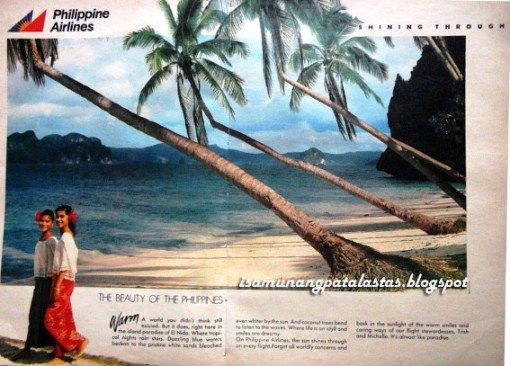 |
| THE BEAUTY OF THE PHILIPPINES. "Casa Manila Classic" Print Ad. Photography: Sandro Tucci, 1986. |
Shining Through: PHILIPPINE AIRLINES
One of the most successful and enduring campaigns of Asia’s
first airline—Philippine Airlines—was conceived in 1986 by the fledgling Avia
Communications, an agency formed by SSC&B Lintas Manila and Avellana &
Associates to handle the airline’s international advertising.
Watch PAL'S "SHINING THROUGH" Launch TV60s.
The result was the memorable and award-winning “Shining
Through” campaign with a theme that reflected the different facets of Filipino
character and the airline: warmth, serenity, charm, hospitality and jazziness.
This was beautifull expressed in the music of the ads—“The beauty of the
Philippines is shining through”.
WATCH PAL'S "Shining Through" TV 30s.
The campaign came at a time when local headlines were
carrying news of Aquino’s assassination, communist insurgency and poverty, so
the beautifully-crafted commercials, print and radio spots were a refreshing
celebration of all things positive about the Philippines. “Shining Through”
presented the Filipino culture in style
as opposed to the clichés of wild, rugged ethnicity.
While the concept, layouts and rough editings were done in
the Philippines, the rest of the production—from sound recording to photography
and post-production –were done abroad.
Foreign editors and directors were also employed. “The job is global, so
we would like our outlook to be global”, explained the late Bobby C. Caballero,
Avia’s Executive Creative Director.
When the “Shining Through” campaign was launched in 1986, it
created a major sensation both here and abroad. The first was when its ads (both
local and international versions) competed against the best at the 10th
Philippine Advertising Congress and triumphed over multinational industry
leaders by winning a record-breaking 24 Awards of Excellence.
 |
| SHINING THROUGH: BEAUTY OF THE PHILIPPINES,Print ad, 1989. |
In 1988, Avia won Best Poster Campaign at the Asean Tourism
Forum and 4 awards at the Creative Guild’s Ad of the Year . The next year, ,
the still-running campaign bagged 3 Anvil Awards, and its print series “Casa
Manila Classic” was adjudged Best Print Campaign at the 16th Asian
Advertising Congress in Pakistan. “Shining Through” also reached the finals of
the Clio Awards in New York for TV Advertising. The campaign was also written
about in international magazines like Time, Newsweek, and Wall Street Journal.
WATCH PAL'S 2016 Miss U Pia Wutzbach
"Shining Through" TVC here:
Avia Communications has long been dissolved, but its
“Shining Through” legacy endures; the campaign theme and jingle are still heard
today, in all-new 2016 PAL commercials that continue to keep the travel and
tourism in the Philippines flying high!
CREDITS:
AGENCY: AVIA COMMUNICATIONS
ADVERTISER: PHILIPPINE AIRLINES
EXECUTIVE CREATIVE DIRECTOR: Robert C. Caballero
CREATIVE DIRECTORS: Bogie Gallardo
COPYWRITER: Debbie Coloma, Bambina Olivares, Russell Jones
ART DIRECTOR: Janau Saldariega
PRODUCER: Russell Jones
PRODUCER: Russell Jones



















